Cutting and sewing technique
Lessons and articles on the nuances of cutting and sewing various types of women's and men's clothing with your own hands. Lessons for working with patterns, patternless cut, tips for beginners on how to sew a skirt, trousers, dress and other clothes. The articles are accompanied by free and paid electronic patterns. Examples of cutting with your own hands and sewing according to ready-made patterns.
Vera Olkhovskaya
This pocket can be used for all products with a yoke on the shelf.
Pocket processing is considered on the example of a boy's shirt (see free pattern of this model).
Base with chest tuck - one of the most common special, as it is suitable for most figures and is easy to build (see the description of the construction of the base with a breast tuck).
special, as it is suitable for most figures and is easy to build (see the description of the construction of the base with a breast tuck).
In addition to simplicity, this base has another very important advantage: with one “light movement of the hand”, in which scissors, it can turn into a base with reliefs.
An example of such a transformation of the bodice is shown in Fig. 1: we cut the back by connecting the shoulder and waist tucks, we can cut the shelf by connecting the tops of the chest and waist tucks or close the chest tuck by transferring it to the waist tuck.
 Based on a chest tuck for dresses and outerwear transformation looks the same - the patterns are cut, connecting the tops of the patterns (Fig. 2 a).
Based on a chest tuck for dresses and outerwear transformation looks the same - the patterns are cut, connecting the tops of the patterns (Fig. 2 a).
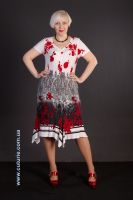 Many home couturiers have difficulties with the processing of necklines, armholes and the bottom of knitwear.
Many home couturiers have difficulties with the processing of necklines, armholes and the bottom of knitwear.
The photo on the left shows a dress with a neckline, the bottom of the sleeves and the bottom of which are “hemmed” without the use of stitching, overlock and handmade.
The dress has withstood more than 10 machine washes and looks as good as right after sewing.
 Classic trousers (picture 1) will always come in handy for a boy for school celebrations.
Classic trousers (picture 1) will always come in handy for a boy for school celebrations.
The model can be sewn not only from suit fabric, but also from worn men's trousers.
Difficulty: medium, but requiring basic sewing skills.
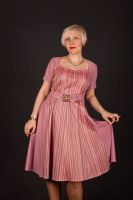 This alteration option is suitable for any dress with reliefs.
This alteration option is suitable for any dress with reliefs. 
It is important that after such an improvement, the dress becomes almost dimensionless and is suitable not only for ladies who tend to gain weight, but also for pregnant women.
In the photo you see the dress already altered: the middle part is replaced by wedges from the companion's fabric.
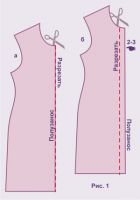 This easy-to-implement idea is suitable for reworking a sheath dress, as well as other symmetrical styles.
This easy-to-implement idea is suitable for reworking a sheath dress, as well as other symmetrical styles.
By inserting one strip 5 cm wide, we, taking into account all allowances, increase the volume of the dress by 1 cm.
A strip of 6 cm - respectively by 2 cm, a strip of 7 cm - by 3 cm.
If more magnification is needed, 2 strips are required.
There is another very important point that I would like to dwell on.
The vast majority of people recover conditionally forward, therefore, to increase the product, it is often enough to increase only the shelf.
A uniform increase in the shelf and backrest is also possible.
Jeans Prep: rip off the belt, cut off or open the side and crotch seams, cut off the seam of the seat and bottom.
Leave the pocket of PP "cutting barrels" - we use it in the product.
At the end of the PP and ZP jeans should be ironed well.
Preparation of vest patterns (see the construction of a drawing of a men's vest) getting started from the construction of the shelf relief.
This is done on the pattern of the base of the vest.
Divide in half the shoulder section of the shelf and the segment located on the horizontal of the barrel from the corner of the armhole to the half-skid.
We alter jeans
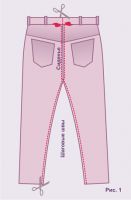 Needless to say, jeans are a cult of our time. They are worn by everyone - from fashionistas to beggars.
Needless to say, jeans are a cult of our time. They are worn by everyone - from fashionistas to beggars.
Let's try to alter jeans - to make small ones out of large ones.
The proposed method allows you to reduce jeans by 2 - 4 sizes.
For a larger reduction, you will have to remove the rivets and / or rip off the factory fasteners from the side seams, front and back pockets, and completely rip off the belt.
But this is laborious and can ruin the product.
Therefore, for a greater reduction, the method of completely redrawing the product is more appropriate. But back to our simple version of the alteration.
We need big jeans and jeans that fit.
Up-to-date information about new patterns in Viber:
My Facebook page
-
Any pattern for free for a review of a previously made order
More...
Lifetime promotion for buyers of patterns!

Leave a review about my store of patterns for an order that you made before, and you will receive any paid pattern of your choice Free!
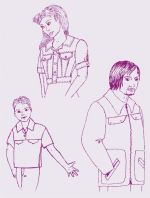

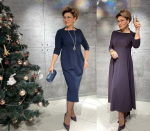





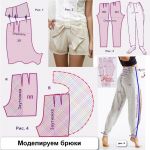
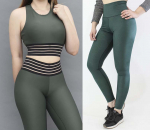




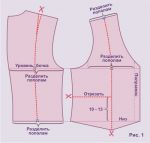
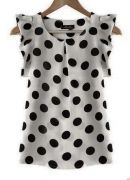

 Join my community on Viber...
Join my community on Viber...










